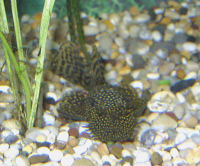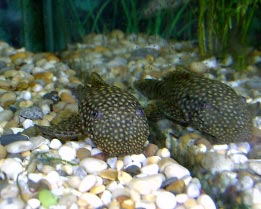The
Bristlenose Catfish.
By Carole Blake

Male Bristlenose

Female
Family:
Loricariidae.
Genera include: Ancistrus Dolichopterus, Ancistrus temminckii,
Ancistrus cirrhosus
If you are looking
for a small, relatively peaceful algae eater, look no further than the
Bristlenose Catfish. It is hardy, will tolerate a range of environments
and will surprise you with its breeding habits. This fish will not get
much bigger than 8-10cm. The male will display the characteristic bristles
on his snout and round his mouth. The female (depending on type) may have
one or two just around the top edge of her snout or none at all. Both
fish have bristles on what can only be described as cheek extensions which
they will flare occasionally!
Tank and water requirements:
Having being imported to the UK since the early 70's, this delightful
little catfish originates from the fast flowing rivers of South America,
and so it likes well oxygenated water. Literature has it that a 60cm length
tank will be enough for one of these fish, but for breeding it is probably
preferable to have at least 90cm. The ph can be anything from 5.8 to 7.5,
temperature from 22-28c and the hardness range from 2-20dGH. As with all
tropicals, ammonia and nitrite must be 0, and nitrate kept below 20ppm.
The ancistrus also requires some bogwood or mopani wood in the tank and
it will rasp away at it to obtain lignin, a substance that it requires
to aid digestion. You will find that a lot of gravel cleaning is required
under the usual resting place of your Bristlenose cat....
Feeding:
You
may find if you read up on the Bristlenose Catfish that it is an algae
eater, and yes, it will clean up your tank for you. However, please do
not ignore the fish's dietary needs. Many people relegate this fish to
the role of tank cleaner/scavenger and do not provide a range of food
for it.
The Bristlenose will eat all of the following lightly
blanched: peas (squeezed out of their skins); courgette (zucchini for
those in the USA); lettuce; spinach; broccoli and cucumber. It is not
by any means vegetarian and will eat bloodworm, sinking tablets and other
protein rich foods. Like all fish, it is not averse to grazing on dead
tankmates.
Breeding:
The
breeding pair can be brought into condition with a mixed diet, good water
conditions (raise the frequency of waterchanges) and a slight upswing
in temperature. It is thought that slightly more acidic than alkaline
conditions will also promote breeding. The male will find himself a niche
under the bogwood, or in a small clay pot if you provide one for him.
He will spend several days cleaning it and fussing around in and out of
it. When he is happy with the nest, he will swim around the female, flirt
up and down the tank with her, and try to entice her back to his lair.
Eventually she will go into his cave and he will follow her in.
The male assumes a position over her, his stomach to her
back, both heads pointing the same way, his body half a length forward
of hers. She lays large amber coloured eggs. (approx 3mm) and the male
fertilizes them immediately. The eggs stick to the sides of the cave.
She may leave the cave but return several times to lay more eggs over
a few hours. Eventually there will be around 30-60 eggs and the female
will swim away to find something to eat!
Meanwhile, the male will begin his long vigil. He will
tirelessly tend the eggs, mouthing and fanning them to keep them constantly
aerated. He will fend off any intruders to the fry by either fanning his
tail furiously at them or physically chasing them off. During all the
time he tends the eggs, he will only leave for the shortest time possible
to eat, and will quickly return to the nest as soon as possible. After
two days eye spots will begin to show on the amber eggs, and after around
five to six days, (depending on tank temperature) the eggs will hatch.
It is quite safe to leave the male with the fry, he will continue to be
a good father and look after them until, at around a week to ten days
after hatching, when they have absorbed their very large egg sacs, they
will leave the cave and venture out to look for food. Eventually the male
will realise that the young have moved out and he will leave the nest.
Care of the
fry:
If
the fry have been spawned in a barebottomed rearing tank, (as opposed
to a mixed community tank) then daily small waterchanges (10% is adequate)
and small meals of the same food types as the adults, (but bloodworm etc.
needs to be chopped up small), will promote quick growth. The bottom of
the tank should be kept clean, uneaten protein foods being removed. The
rate of fry survival is generally high and provided the tank is maintained
correctly, then there should be no real problems in raising the fry to
a saleable size within three months. Most tropical fish shops will take
them from around three cms long.
If the fry have been
spawned in a community tank; depending on where the male made his nest,
it is perfectly possible to move the entire nest to a seperate rearing
tank (to protect the small fry from predators); however this must
not be done until the fry have hatched as if the male leaves
them before then, the eggs will not be sufficiently fanned and aerated
and may become fungussed. In the past, this author has moved clay pots
full of fry, (with the male still hanging on for dear life) by means of
immersing a deep container inside the main tank, moving the nesting pot
gently into it within the tank, and carefully lifting
the whole container out and into the rearing tank. If the male leaves
them at this point, it will not matter, his main job has been done.
Bristlenose Catfish, with care, will live long and useful
lives in the aquarium. Given optimum conditions they may breed as often
as every five or six weeks and will continue to do so for many years.
Sources in Australia have had these great fish living up to twelve years
and over in tanks, continuing to produce young for the entirety. Here
in the south west of the UK, they are in demand in tropical fish shops
because of their small size, and home breeders will find a ready market
for them.
|







